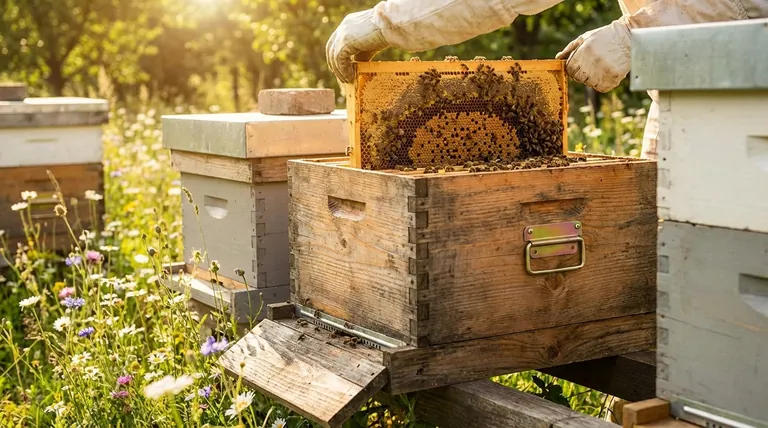At the heart of every healthy beehive is the brood box. Its primary purpose is to serve as the colony's nursery, providing a dedicated and protected space for the queen to lay eggs and for worker bees to raise the next generation of bees. It is the engine room of the hive, where the colony's population grows and develops.
The brood box is not just a piece of equipment; it is the functional center of the bee colony. Understanding its role is the key to understanding the colony's health, growth, and overall productivity.

The Brood Box: The Colony's Engine Room
The term "brood box" or "brood chamber" describes what the bees are doing inside it. It is the central hub of activity focused on reproduction and population growth.
The Queen's Domain
The brood box is where the queen bee lives and performs her primary function: laying eggs. In peak season, a healthy queen can lay over 2,000 eggs per day. The entire box is organized to support this critical task.
A Complete Nursery
This chamber contains the "brood," which refers to all the developmental stages of a bee. Inside the wax cells, you will find eggs, larvae (the small, white grub stage), and pupae (the capped cells where larvae transform into adult bees).
The Hive's Internal Pantry
Worker bees also use cells within the brood box to store pollen and nectar. This food is not surplus for the beekeeper; it is the colony's immediate food supply, used to feed the queen and the developing brood.
How the Brood Box Dictates Hive Management
The placement and management of the brood box are fundamental to the practice of beekeeping. It forms the foundation upon which the rest of the hive is built.
The Foundation of the Hive
The brood box is typically the bottom-most box in the hive stack, resting directly on the bottom board. This position makes it the literal and figurative foundation of the colony's home.
Separating Brood from Surplus Honey
Beekeepers want to keep the queen and her brood out of the boxes used for honey collection. A screen called a queen excluder is often placed on top of the brood box. It allows worker bees to pass through to the honey boxes (or "supers") above but is too small for the queen to fit through.
This separation ensures the honey harvested by the beekeeper is pure and free of eggs or larvae.
Understanding Common Management Decisions
Your strategy for managing the brood chamber directly impacts colony size, swarm tendency, and the physical effort required for inspections.
Single vs. Double Brood Boxes
A common decision is whether to use one or two boxes for the brood chamber. A single brood box is lighter and easier to inspect. However, a vigorous queen can quickly run out of laying space, which can trigger the colony to swarm.
A double brood box setup provides ample room for a large population, reducing swarm pressure and creating a powerful workforce for collecting nectar. The primary downside is that the hive becomes significantly heavier and more cumbersome to inspect.
The Risk of a "Honey-Bound" Brood Nest
A potential problem occurs when bees fill the brood-rearing cells with nectar, leaving no room for the queen to lay eggs. This is known as being honey-bound.
This condition can severely limit the colony's growth and must be managed by the beekeeper, often by adding more space or rearranging frames.
Making the Right Choice for Your Goal
Your approach to brood box management should align with your specific beekeeping objectives and physical capabilities.
- If your primary focus is simplicity and easier lifting: A single brood box setup is a viable option, but it requires vigilant monitoring to prevent swarming.
- If your primary focus is maximizing colony population for honey production: A double brood box configuration provides more space for the queen, but be prepared for heavy lifting.
- If you are in a region with short, intense nectar flows: You must actively manage the brood nest to ensure the queen does not become honey-bound, which would halt colony growth.
Mastering the management of the brood box is the first and most critical step toward guiding a thriving, productive colony.
Summary Table:
| Brood Box Function | Key Takeaway |
|---|---|
| Primary Purpose | Serves as the nursery for egg-laying and brood development. |
| Colony Impact | Dictates population growth, health, and swarm tendency. |
| Management Options | Single box (lighter) vs. Double box (reduces swarming). |
| Common Issue | Risk of becoming "honey-bound," limiting queen's laying space. |
Equip your apiary for maximum productivity with HONESTBEE.
Managing a brood box effectively requires durable, well-designed equipment. As a trusted wholesale supplier for commercial apiaries and beekeeping equipment distributors, HONESTBEE provides the robust brood boxes, frames, and queen excluders you need to build a strong foundation for your colonies.
We understand the challenges of large-scale beekeeping. Our products are built to withstand heavy use and support the intensive management practices that lead to thriving, high-yield hives.
Contact our wholesale team today to discuss your equipment needs and bulk pricing. Let us help you strengthen the engine room of your operation.
Visual Guide

Related Products
- Professional Drop-Style Hive Handles for Beekeeping
- HONESTBEE Entrance Bee Feeder Professional Hive Nutrition Solution for Beekeeping
- Professional Hive Front Entrance Bee Feeder
- HONESTBEE Professional Entrance Bee Feeder Hive Nutrition Solution
- Professional Engraved Round Hive Number Tags for Beekeeping
People Also Ask
- Why are hive tools painted in bright colors? Prevent Losing Your Essential Beekeeping Gear
- What makes polyurethane foam environmentally friendly? The Surprising Benefits of a Durable, Inert Material
- Why is proper beekeeping equipment important? Essential for Safety and Hive Health
- What is beekeeping equipment? Essential Tools for Commercial Apiaries & Distributors
- What are the characteristics of the bristles on a bee brush? Designed for Gentle Persuasion, Not Force



















